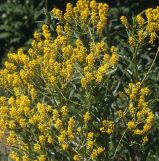| Common Name: |
Woad |
| Botanical Name: |
Isatis tinctoria |
| Genus: |
Isatis |
| Family: |
Brassicaceae |
| Cultivation: |
Rich, well-drained, neutral to alkaline soil in sun. |
| Propagation: |
By seed sown in autumn or spring. Often self-seeds readily, but does not thrive in the same soil for more than two years. |
| Harvest: |
Leaves are picked in summer for use fresh or dried in decoctions, or macerated for extraction of blue pigment, which is then dried as a powder. Roots are lifted in autumn and dried for use in decoctions. |
| Native Location: |
C and S Europe, W Asia |
| Height: |
50cm-1.2m (20in-4ft) |
| Width: |
45cm (18in) |
| Hardiness: |
Z3-8 |
| Parts Used: |
Leaves (da qing ye), roots (ban lang gen), pigment (qing dai). |
| Properties: |
A bitter, chilling herb that lowers fever and reduces inflammation. It controls a wide range of pathogenic organisms, including viruses, and reputedly has anti-cancer effects. |
| Medicinal Uses: |
Internally for meningitis, encephalitis, mumps, influenza, erysipelas, heat rash, sore throat, abscesses, and swellings (Leaves, roots); convulsions and high fevers in children, coughing of blood, and as a detoxifier in infections such as mumps, erysipelas, and yeast (pigment). |
| Bibliography: |
Encyclopedia of Herbs by Deni Brown. Copyright © 1995, 2001 Dorling Kindersley Limited. pp 244-245
|

